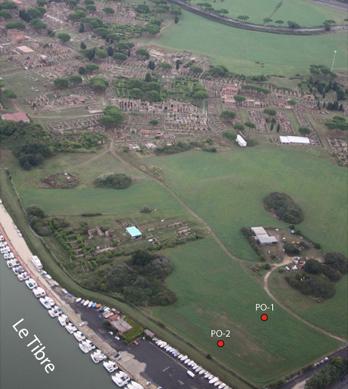picture courtesy of 2.cnrs.fr
French and Italian archaeologists have found the location of the port that supplied Ancient Rome with wheat.
France’s Centre National de la Recherche Scientifique (National Centre for Scientific Research, CNRS) announced that the harbour has been located northwest of the city of Ostia, on the left bank of the mouth of the River Tiber. Stratigraphy revealed that between the 4th and 2nd centuries BC the basin’s foundation was deeper than 21 feet – the depth of a seaport.
The archaeological site of Ostia Antica is what remains of Rome’s most ancient colony. The settlement is thought to have given Rome an outlet to the sea, ensured its supply of wheat and salt, and prevented enemy fleets from entering the Tiber.
Archeological excavations showed that the original urban core dates to the turn of the 4th and 3rd centuries BC. Major ancient buildings and main roads were revealed over time, but the location of the Ostia river-mouth harbour remained unknown. For some, it was considered ‘lost’ forever.
At the turn of the century, archaeologists confirmed the probable location of the basin in the area by using geomagnetic instruments. However, there was still no consensus on the exact location of the port. A French-Italian team led by CNRS researcher Jean-Philippe Goiran has verified the hypothetical location of the harbour by using a geological corer. The technology tackles the problem of groundwater that makes the area difficult for archeologists to excavate beyond 6 feet deep.
Two sediment cores have been extracted that reveal the evolution of the harbour. The deepest stratum, before the foundation of Ostia, indicates that the sea was present in that area in the early 1st millennium BC. A middle layer shows facies (rock and sediment formations) typical of a harbour. According to calculations, the basin had a depth of 6 feet at the beginning of its operation between the 4th and 2nd centuries BC. Previously considered a river harbour that could only accommodate low draft boats, Ostia enjoyed a basin capable of receiving deep draft marine ships. The most recent stratum reveals that the basin was abandoned during the Roman imperial period.
With radiocarbon dating, it is possible to deduce that a succession of major floods sealed Ostia harbour between the 2nd century BC and the beginning of the 1st century AD. It was then abandoned in favour of a new harbour complex built north of the Tiber mouth, called Portus.
The discovery of the river-mouth harbour of Ostia, north of the city and west of the Imperial Palace, will help better understand the links between Ostia, its harbour and Portus, initiated in 42 AD and completed in 64 AD. The gigantic complex became the harbour of Rome and the largest ever built by the Romans in the Mediterranean.
However, researchers estimate that nearly 25 years passed between the abandonment of Ostia’s port and the construction of Portus. This raises the question of how wheat was supplied to Rome – the capital of the Roman Empire and the first city to reach one million inhabitants – during that period.







